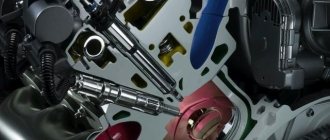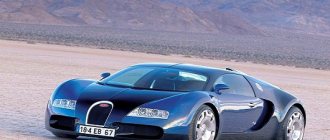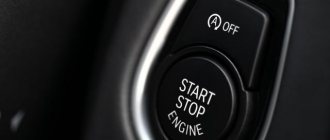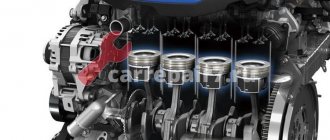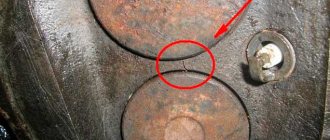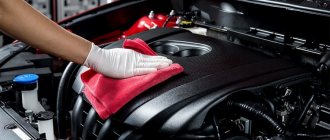Improved car model Mercedes ML W164 was discontinued several years ago. However, those copies of this model that appeared on the market much earlier cost more than two new Dusters. Therefore, now we will figure out whether it is worth paying crazy money for a used Mercedes ML.
The Mercedes W164 body is characterized by so-called exemplary survivability. Its outer surface is covered with high-quality paint and varnish, such a paint coating is durable and long-lasting. Metal, as is typical for Mercedes, is also durable and properly processed, therefore, the owner of this model can forget about the word “corrosion” for a long time. Even the chrome on the outside looks presentable; of course, the chrome on older examples slightly loses its luster, but this is all an everyday matter. In general, the Mercedes ML body deserves respect.
The interior of the car is no less attractive. So, you need to try hard to at least somehow wear out the interior trim, because it is made of reliable and durable materials. Only the trunk curtain and the backs of the rear seats can creak in the cabin, and only after a long time. The interior is durable, so only the appearance of the wooden finish deteriorates - cracks form on the varnish surface.
The only sore subject is the electronics installed in the cabin. Cars that were produced for the first time sometimes experience interruptions in the functioning of the climate control system. The driver needs to either reflash or install another KLA control unit, which, by the way, is not cheap - about 1000 euros. In addition, after several years of operation, the heater motor, as well as the air damper servos, begin to act up. Replacing these parts will cost the car owner approximately one thousand euros.
After some time, you will notice that the audio system can be “greedy” at times and will not release discs. Therefore, you will have to install a brand new CD changer. Quite often pressing the buttons located on the steering wheel, the sound signal stops responding, and therefore you have to install a new steering column wiring harness.
The real scourge for drivers is oxidized electronic circuit boards. At first glance, a minor nuisance, consisting of a deteriorated quality of the rubber seal on the right rear light, can result in either a brake light suddenly going out or a damaged rear unit of the SAM information processing system.
The front SAM units installed in the space under the front passenger seats have an equally unimportant reputation. As soon as a small amount of moisture gets in there, the instrument lighting immediately begins to malfunction and all electronic devices located in the front part of the cabin may turn off. And new such SAM blocks cost around 400 euros.
Unlike the surface of the body, the outer handle of the driver's door is quite easily susceptible to corrosion. Poor contacts cause poor performance of the optional Keyless Go system. In most cases, after a few years, the door locks also have to be replaced because the springs in them break.
Due to software glitches, the electric lock on the trunk begins to malfunction, and after a few years the plastic structure may completely collapse. Around the same period, many begin to notice malfunctions in the tailgate servo drive, which are “treated” as a result of recalibration.
But the biggest problem should be expected in about eight years. It is then that the owner of a Mercedes ML may be surprised by the “behavior” of the ignition switch, which will not respond to the transponder key and, as a result, simply will not start the engine.
Motors in Mercedes ML
The most popular model is the M272 petrol “six”, which has a volume of 3.5 liters. It makes up a significant part of the entire automotive market. This machine is characterized as the most problematic. In vehicles that have not undergone restyling, the plastic swirl flaps are observed to jam, after which it is necessary to purchase a new intake manifold. But for newer cars (released after 2007) this defect has been corrected.
The car uses 2 batteries, costing 55 and 70 euros. They typically last about 5 years and provide power to all the electronics in the cabin. The Mercedes ML has a fairly reliable generator; it can easily operate for 250,000 km; the starter solenoid relay may break down after about 100,000 km. To change it you will need 45 euros.
However, the sore spot of this motor lies in the cermet gear of the balancer shaft drive. Its teeth sometimes wear out so much that a shift in valve timing occurs, and chips and crumbs adversely affect the functioning of the oil pump, the cost of which is approximately 170 euros.
When purchasing a used car, you should pay attention to the presence of “diesel” knocking, as well as to the proper functioning of the engine. to carry out such a test on a Mercedes ML , otherwise you will have to fork out money for its repair, which requires the mandatory removal of the engine, which is approximately 2,500 euros. At the same time, you can at the same time install a new valve timing adjustment clutch and a drive chain with stabilizers and tensioners, which will all stretch evenly over time.
The few owners of ML with a V8 engine of the M273 series should not relax too much. They will also face problems with gears. Its only advantage is that there is no need to remove the engine when replacing the balancer shaft.
The most reliable model is the “eight” M113. It can be compared to a tank, but such a “rarity” is very rare. Therefore, connoisseurs of reliability should consider, as an option, the diesel “six” OM642. While driving it, you can encounter a rather serious problem only when driving the pre-restyling version, which was released no later than 2007.
The interior surface of these cars is made of the wrong material. In addition, after about 150 thousand kilometers, the welds begin to crumble very quickly. Metal chips fall into the turbine, as a result of which it stops working.
Heart of the machine
In Russia as a whole, the most common engine version for the Mercedes-Benz ML is the 3.5-liter gasoline V-six with a power of 272 hp. Its weak point is the accelerated wear of the cermet gears of the balance shaft, which makes itself felt already after a mileage of 40–50 thousand km. It’s good if the previous owner managed to carry out repairs under warranty, otherwise it will cost at least 100 thousand rubles. In the worst case scenario, this breakdown can lead to a violation of the position of the camshafts; metal shavings are formed from their friction, which can “kill” the oil pump. Another problem with this engine is that by 50 thousand kilometers, the control rods of the intake manifold flaps may fail, causing the engine speed to “float” and the “Check engine” lamp on the instrument panel to light up. The cost of repairing the intake manifold is 45 thousand rubles.
In large cities, where there are many network gas stations that maintain an acceptable level of diesel fuel quality, diesel power units are more common. For operation in megacities, such engines have several advantages: lower fuel consumption, high torque, which means a dynamic start, and lower transport tax due to lower power. Thus, in Moscow, the first place in sales is occupied by the Mercedes-Benz ML with a 3-liter V6 diesel engine, which comes with four boost levels - from 190 to 230 hp. It is extremely rare to find cars with a 4-liter V8 diesel engine, and even then it is better to avoid them. A car with such an engine, of course, demonstrates excellent dynamics, but the engine itself has a lot of operational problems and is very expensive to maintain. The weak point of all diesel engines is that carbon deposits from the exhaust manifolds kill the turbine, and its repair will upset even wealthy car owners, as it will cost about 250 thousand rubles.
Whatever engine the Mercedes-Benz ML is equipped with, they are all coupled with a 7-speed automatic transmission 7G-Tronic, which has a typical problem: hydraulic valve blocks fail so often that the manufacturer has released a special repair kit, which is a board and valve Although dealers do not always have such a kit in stock, it significantly reduces the cost of repairing an automatic transmission - from 90 thousand rubles for the entire electro-hydraulic transmission control unit to 32 thousand for a repair kit.
Transmission
One thing is good: you don’t have to rack your brains with choosing the type of gearbox. After all, today there is no alternative to the 7-speed automatic Mercedes G-tronic 722.9. It was created in 2005 and even then had a large number of minor shortcomings. The ISM module experiences faults that prevent the selector from being switched. The main drawback is the weak Siemens ECM electronic control board. The latter is not able to withstand frying in a special oil box for a long period. In this regard, a temperature of 130 degrees is considered fatal for it.
The valve body, combined with the ECU into one system, is also not famous for its reliability, because over time the control solenoids become unusable. As a result, the clutch packs are damaged. Exactly the same consequences can occur due to improper operation of the oil pump, whose gears become deformed after crossing the 150,000 kilometer mark.
However, all of the problems described above often only apply to cars that were produced before 2007. In other models, only one drawback appears - in the places of rolling, the cooling tube of the “automatic” leaks. But the box itself has the ability to travel about two hundred thousand kilometers without supernatural effort.
The transfer case can last about the same amount of time. But occasionally another breakdown occurs after every hundred thousand kilometers. There may be a strong grinding noise that occurs under the influence of the load from a stretched chain, as well as beeps after accelerating if the planetary gear bearings are already worn out. As a rule, the cause of the hum is the driveshaft outboard bearing, which changes along with the driveshaft. Replacement of the gearbox is required if vibrations are felt in the front gearbox.
The shortcomings in the Mercedes ML don't end there. Many car owners complain about uncharacteristic sounds in the steering system. For specimens that are more than eight years old, it is better to immediately replace the power steering pumps, as well as the reservoir. Such measures are carried out for the purpose of prevention, because the filter mesh becomes clogged after a few years and quickly fails.
As for the steering rack, it breaks extremely rarely, but it can leak. This drawback can be corrected using an original set of seals with oil seals. The play in the steering shaft driveshafts should be checked after a noticeable knocking sound appears when turning the steering wheel.
Mercedes-Benz ML W164 (2005-2011)
After modernization in 2008, the seven-speed automatic transmission lost almost all of its congenital diseases, except for the fragile cooling tubes that leak in the rolling areas. Replacement - from 8500 rub. According to the regulations, the oil in it is changed every 60 thousand km, and our experts recommend doing this every 40 thousand km - in our conditions this is advisable.
The Pro Off-Road drivetrain is built to last. The transfer case, like the automatic transmission, usually withstands 200 thousand km. Sometimes, before this period, the chain stretches (9,500 rubles) and the bearings begin to hum. However, the sound can also come from the outboard bearing, which dealers replace together with the driveshaft (40,000 rubles). In specialized technical centers, the bearing can be replaced separately for 6,500 rubles. After 150 thousand km, you have to change the front gearbox (43,000 rubles), the imminent death of which will be announced by hum and vibration.
Chassis and body
The spring suspension of the standard Mercedes-Benz ML is as strong as tank armor. The first to be sold in the front suspension at 60–90 thousand km are the stabilizer struts (1,500 rubles each). And only at 120–150 thousand km comes the turn of shock absorbers (10,800 rubles each) and lower arms (3,500 rubles each), which become unusable due to wear of their silent blocks. The rear suspension elements are even more reliable and last on average one and a half times longer. The only exceptions are shock absorbers (8,500 rubles each), which last an average of 100–130 thousand km.
The spring suspension is durable and requires repair only after 120 thousand km. At the same time, in the pneumatic Airmatic you will have to change the struts mounted with shock absorbers, which cost 52,000 rubles each. a piece. And in order for them to live safely until this period, they should be washed every time the car is washed.
In the steering system, after 100 thousand km, the rods are changed (2,300 rubles each). The rack lasts for 200 thousand km, but can begin to leak much earlier than this period - it is eliminated by installing oil seals and seals from the repair kit (from 1000 rubles). And if it starts knocking, first check the steering shaft driveshaft (RUB 8,000). But the power steering pumps (RUB 22,000) were often replaced under warranty at first. When replacing, it is advisable to also update the tank, the filter mesh of which quickly becomes clogged.
Rear suspension elements “live” one and a half times longer than front suspension elements. But again, the exception is air cylinders, which become unusable after 130 thousand km. True, they do not cost as much as the front ones - only 14,000 rubles each.
The Airmatic air suspension is more finicky and expensive. Pneumatic cylinders rarely withstand more than 120–140 thousand km, and they are not cheap: front ones complete with shock absorbers cost 52,000 rubles each, and rear ones cost 14,000 rubles each. To extend their life, it is advisable to wash the cylinders at every wash. And if the car starts to make extraneous knocking noises when driving over uneven surfaces, check the fastening of the front pneumatic elements to the struts - the fasteners weaken over time and require simple tightening.
The body is heroically resistant to corrosion, and the paintwork is durable. Even chrome parts do not lose their shine for many years. The main thing is that a car handcrafted after an accident is not sold to you under the guise of a worthy copy.
On variants with the Pro Off-Road package, the design of the center console differs from the basic version.
But electricians present unpleasant surprises with age: there are interruptions in the operation of the climate control, the heater motor torments with serenades, the air damper servos begin to live their own lives (8 pieces, 3,500 rubles each), the sound signal and buttons on the steering wheel glitch, swallows CDs -player... Moreover, treatment is by no means cheap.
Modification
Mercedes-Benz offers charged AMG versions for almost all of its models. And the M-Class is no exception. Moreover, it should be noted that from the point of view of safety margin and durability, these modifications are preferable to civilian ML. After all, more stringent quality control is used in the manufacture of these machines. The engines are assembled by hand - each has the personal mark of the master, who gives the motor an almost lifetime guarantee. And the 7-speed automatic transmissions have been refined and refined to handle higher torque. Externally, the ML 63 AMG is distinguished by different bumpers and an aerodynamic body kit around the perimeter of the body. Under the hood is a petrol 6.2-liter V8 equipped with a compressor. The engine develops 510 hp. and 630 Nm, which allows the heavy SUV to accelerate to 100 km/h in just 5.0 s, and the top speed is electronically limited to 250 km/h. By the way, the V8 does not suffer from a lack of appetite at all.
Mercedes-Benz ML 2008
Restyling
In 2008, the Mercedes-Benz ML underwent restyling, which most noticeably affected its appearance. There have been no radical changes in the interior, except for the appearance of improved finishing materials. The updated car is most easily recognized by the headlights, the inner lower corners of which are now lowered, a modified front bumper into which foglights of a different shape are integrated, as well as an updated radiator grille. The rear features new LED lights. There are few technical innovations for Russian-spec cars. Thus, in the engine range, instead of a 5-liter V8 (M113), a power unit with the same number of cylinders of 5.5 liters and a power of 388 hp appeared. And the turbodiesel 4-liter V8 left the engine line after 2008.
